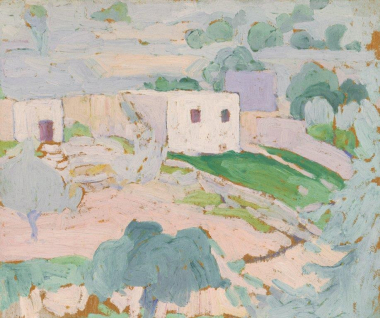Chapel (?), 1923

Spyros Papaloukas was a distinguished Greek painter and a forerunner of the 1930s Generation. Born in Fokida, he was accepted into the Athens School of Fine Arts in 1909 and studied under Georgios Roilos, Georgios Iakovidis, Spyros Vikatos, and others. While still a student, he painted icons for the iconostasis at the church of Agios Dimitrios in Desfina. From 1916 to 1921, he continued his studies in Paris at the Julian and Grande Chaumière academies.
While in Paris during the four years 1917-1921, he painted incessantly and visited museums and galleries. He saw the revolution taking place in art and attempted to understand it but rejected any thought of imitating it. It was a time where all of the major upheavals in modern art had already occurred – fauvism, impressionism, cubism, expressionism, abstraction – and surrealism was emerging. Besides, Papaloukas was of the same generation as the surrealist artists. But none of these currents influenced him directly. His “focus on the object” would bring him closer to the post-impressionist movements, from which all Greek modernists drew inspiration.
In 1921, he left Paris and his studies in medicine and painting and returned to Greece to follow the Greek Army to Asia Minor as a war artist, along with Periklis Vyzantios and Pavlos Rodokanakis. Conscious of his duty to contribute with his own efforts to this important moment in history, he left for Smyrna. His time in Asia Minor was extremely fruitful. He created nearly 500 works – sketches, ink drawings and watercolours, which were shown in January 1922 at the Zappeion Megaron as part of the “First war exhibition of the Asia Minor Army”.
In 1940, he was named advisor to the City of Athens on urban and spatial planning issues and from 1941 to 1957 served as director of the Athens Municipal Art Gallery. He taught drawing at the School of Architecture of the National Technical University of Athens from 1945 to 1951, and in 1956 was elected professor at the Athens School of Fine Arts.
He died in 1957 in Athens, having earned his place amongst the most prominent modern Greek painters. His work was presented posthumously at the Greek National Gallery in a retrospective exhibition in 1976 and at the City of Athens Cultural Centre in 1982. In 2006, his daughter and sole heir, Asimina Papalouka, donated almost the entire body of his work to the B. & M. Theocharakis Foundation for the Fine Arts & Music, whose founder had been a student of Papaloukas.





